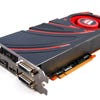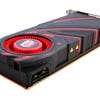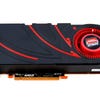Radeon R9 270X review
"They've rebadged it, you fool!"
It's clear AMD has a big game plan. Not content with being the supplier of the core hardware found in both PlayStation 4 and Xbox One, it has also announced an intriguing alternative to the DirectX 11 API - named Mantle - to give exclusive performance benefits across its Graphics Core Next-based cards. Mantle seeks to outperform the DirectX 11 standard by offering low-level access to AMD graphics technology, with Battlefield 4 the first game to utilise it.
However, this is only one side of a double-pronged assault. AMD's 7000-series graphics tech is being renewed. We've already looked at the R9 280X and now the focus shifts to the R9 270X - a mid-range card at the heart of a new generation of GPUs using this very architecture. Launching at around £160, according to AMD, the card aims to usurp Nvidia's GTX 660 for performance-per-pound in the same space. However, with AMD's attention so divided between multiple projects this year, can this be taken as the company's definitive response to Nvidia Kepler cards at this price?
As touched on in our R9 280X review, the nomenclature of AMD's cards has gone through a vexing change. In basic terms, the R9 series - into which this 270X card falls - is intended for an enthusiast audience looking to chase gaming performance at up to 2560x1440. Meanwhile the R7 bracket caters for buyers spending around the £100 mark on a card capable of achieving 1080p in most games. But of course, this is mostly about branding categories, and when we turn to the specifics of the hardware itself it's apparent we're looking at a very familiar PCB design here.
Indeed, the R9 270X's specs give us an acute sense of déjà vu, Just as the R9 280X builds off the Tahiti chipset seen in the HD 7970, the silicon of the R9 270X is in fact the same as the Pitcairn XT-based HD 7870 of last year. However, while the components are identical, this refresh actually introduces some impactful changes over its predecessor. For starters, the core clock goes up from 1000MHz to 1050MHz, while more crucially the memory clock gets a boost up from 4.8GHz effective to 5.6GHz. It's a bigger mix-up than we see with the higher-end 280X, which remains faithful in most ways to its original incarnation as released early last year.
It's this latter boost that ties in nicely with the push for 2560x1440 resolutions in the R9 series. The 256-bit memory interface stays the same as before, and so the card's memory bandwidth benefits from an upward spike to 179.2GB/s (up from 153.6 GB/s on the HD 7870). In terms of RAM, it's also now possible to buy the card with a whopping 4GB configuration of GDDR5 memory, better future-proofing you for the arrival of next-gen console - though for review purposes our focus is on the more competitively priced 2GB model.
Physical dimensions of the card are mostly a match for its forebear, measuring in at just over 24cm in length, which makes it among the bulkier mid-range GPUs in the market. You'll also need to fill two 6-pin power connectors on top to give it juice, while to its end we have two DVI ports, a DisplayPort and a HDMI input. Sadly, the TrueAudio sound processing features announced for the R7 260X aren't included in this model, being tied to the GCN 1.1 architecture revision of the Bonaire chipset. That said, following many requests, we can now hook three monitors up to the card without resorting to the DisplayPort - the proviso being that your monitors must be matching (in order for the timings of the DVI controller to be in sync), and that each of these be active during the PC's boot-up.
Turning the PC on, the heat output of the card reads at 29 Celsius while idle on desktop; a good start that shows AMD's ZeroCore technology is still at play to automatically scale clock speeds by demand. Finding the peak temperatures of the R9 270X is easy enough too, and with an hour's worth of repeat 1080p runs through the Metro Last Light benchmark at very high settings, our monitoring software gives us 75 degrees Celsius as its maximum. This falls in line with our HD 7870 readings, which doesn't give terribly much head-room for a serious core overclock. Given that the clocks have already been raised on the manufacturer side for the newer card, it's been necessary to raise the thermal design power (TDP) limit of the device slightly from 175W to 180W also.
Next up, we take Crysis 3 for a spin to test actual gameplay performance. Before we start, our AMD Catalyst drivers are fully updated to the latest 13.11 beta revision, and we have the card installed to a PC equipped with an Intel i7-3770k processor clocked at 4.3GHz per core, plus 16GB of DDR3 RAM operating at 1600MHz. This is the standard setup for our benchmark tests below too, and where Nvidia cards are involved, we have the latest 327.23 drivers installed.
"Our Crysis 3 gameplay stress test proves to be just too much for the Radeon R9 270X - 60fps is off the table at both resolutions, and we'd recommend capping to 30fps for a more consistent experience."
Rather than simply crank all of Crysis 3's settings to maximum, which enormously impacts performance on all but the most high-end cards, instead we go with the next setting down. High settings and very high textures still give our card a thorough work-out, especially during grassy areas of the Welcome to the Jungle mission. Sub-pixel morphological anti-aliasing (thankfully abbreviated to SMAA) is engaged to treat the image's rough edges at minimal expense - the multi-sampling alternative being far too costly at 1080p and 2560x1440 resolutions.
The results are impressive, but CryEngine 3 does find a way to eat up the card's abundance of processing power, resulting in uneven playback at either resolution. The long and short of it is that those with a 2560x1440 monitor hooked up have to consider making some sacrifices with the R9 270X. Even with the card's respectable fill-rate, the frame-rate at these settings is truly stable only with a 30fps cap present. Meanwhile, the 1080p side gives us a smoother ride overall while shooting around the derelict train station area, but it's still shy of the consistent 60fps mark. Alas, the only we can hit this target is by dropping general settings to medium.
Of course, Crysis 3 is an anomaly in the PC gaming scene in terms of making these high technical demands, while most other games far exceed this rate of performance. Taking our benchmark tests below as an example, all of which aim to stress the card at the highest settings possible, games like Tomb Raider and Bioshock Infinite show it's possible for the card to deliver 2560x1440 at full-fat 60fps. In our four-way tests, we pit the R9 270X against its arch-rival from Nvidia, the GTX 660, and also see if tweaks to its core and memory clocks have amounted to a tangible improvement over the HD 7870.
"These mid-range cards tend to be sold as offering the full 1080p experience with max settings - which is fine if you're happy with 30fps gaming on some key titles. Realistic settings tweaks offer much the same experience with much higher performance."
| 1920x1080 | R9 270X | Radeon HD 7870 | GTX 660 | GTX 760 |
|---|---|---|---|---|
| BioShock Infinite, DX11 Ultra DDOF | 55.0fps | 52.2fps | 52.3fps | 68.8fps |
| Tomb Raider, Ultra, FXAA | 74.2fps | 71.1fps | 60.1fps | 77.5fps |
| Metro 2033, Very High, 4x MSAA | 31.4fps | 28.5fps | 25.8fps | 31.2fps |
| Metro: Last Light, Very High, SSAA | 24.1fps | 22.6fps | 21.4fps | 27.7fps |
| Hitman: Absolution, Ultra, 8x MSAA | 30.8fps | 29.2fps | 22.8fps | 30.1fps |
| Sleeping Dogs, Extreme | 36.9fps | 35.4fps | 32.5fps | 42.5fps |
Of all the benchmark tests in our roster, perhaps the most revealing of AMD's strengths is Hitman: Absolution - a game apparently optimised specifically for its GPUs. The benchmark route takes each GPU's memory bandwidth to the absolute brink on ultra settings at 8x MSAA, where hundreds of NPCs flock around a fireworks display as the camera slowly pans past. The end result for the R9 270X is one which beats out the HD 7870 and even the GTX 760 by a constant margin of 2fps at its peak - a surprise given the latter card's higher £175 price point. Faring the worst of the bunch is the GTX 660, which falls behind by 8fps on average owing in part to its fewer 24 render output units (ROPs), compared to the 32 available on the other three cards as well as the more constricted memory interface.
Metro Last Light proves to be a similar burden on all cards, but the outlook is much more positive for games like Tomb Raider. In all these tests we avoid engaging v-sync to allow each card to hit maximum theoretical performance, where usually each would squash up to the 60fps ceiling. Lara Croft's latest reboot shows us how a massive action game can run at above this refresh on every card - where the R9 270X actually runs at a 23 per cent advantage over the GTX 660.
In terms of comparisons with the HD 7870, the core and memory clock boosts show their greatest practical gains in Tomb Raider with a 3fps average lead. It's barely noticeable in practise for most other games, and when considering the HD 7870 is a cheaper card at present too, the gains can't really be seen as worth the extra expense of £15. On the other hand, the GTX 760 dominates the results tables, as far as 1080p play goes - though this lead narrows at 2560x1440.
Running at this higher resolution with graphics settings a notch lower, we see the GTX 760 push ahead of AMD's cards in almost every test - even winning by a matter of 7fps in Bioshock Infinite at very high settings. Hitman: Absolution is again the exception to the rule in these metrics, being a real memory bandwidth monster at 8x MSAA in tandem with this resolution, which forces the GTX 660 to an all-time lowest rate of 14fps. Other tests, such as Metro Last Light with its quality settings and tessellation enabled in full, tend to bring all cards down to an indistinguishable tussle for 20fps - though again the GTX 760 heads the pack, with the R9 270X in second, and the GTX 660 trailing by the widest margin.
"Memory and clock upgrades give the R9 270X a boost against its Radeon HD 7870 forebear, but it's perhaps still a little too close to justify the rebranding."
| 2560x1440 | R9 270X | Radeon HD 7870 | GTX 660 | GTX 760 |
|---|---|---|---|---|
| BioShock Infinite, DX11 Very High | 54.8fps | 50.8fps | 46.6fps | 61.0fps |
| Tomb Raider, High, FXAA | 66.2fps | 59.9fps | 51.3fps | 76.4fps |
| Metro 2033, High, 4x MSAA/AAA | 24.1fps/ 27.3fps | 20.1fps/ 23.0fps | 20.7fps/ 26.1fps | 25.0fps/ 29.7fps |
| Metro: Last Light, High, No SSAA | 44.8fps | 43.0fps | 36.7fps | 34.5fps |
| Hitman: Absolution, High, 8x MSAA/2x MSAA | 21.7fps/ 39.2fps | 20.2fps/ 36.9fps | 14.0fps/ 28.9fps | 20.3fps/ 40.2fps |
| Sleeping Dogs, High | 44.3fps | 42.8fps | 37.9fps | 49.5fps |
Radeon R9 270X: the Digital Foundry verdict
All in all, our assessment of AMD's latest mid-range entry boils down to timing and price - and the wild card that is the upcoming Mantle API. Right now there's no escaping the fact that the soon-to-be discontinued HD 7870 serves up very comparable performance figures at 1080p to the R9 270X, with the latter card selling for a premium due to a simple mixture of what seems to be upclocked hardware. The figures are as you'd expect given the two cards use precisely the same Pitcairn XT chipset, where the clock boost on the R9 270X does little to distinguish the card from its predecessor at this resolution.
But that's not the whole story; where gaming at 2560x1440 is concerned, the bump of 800MHz to the R9 270X's effective memory clock amounts to a considerable frame-rate uptick. This advantage can be narrowed on the HD 7870 through a likewise overclock, but the difference does mitigate the newer card's price hike of £15 overall - albeit only if you intend to crank up the pixel count to that point. Otherwise, the added bonus of AMD's ongoing silver Never Settle promotion is only applicable for HD 7870 buyers as of writing, meaning there's essentially two games in the offing if you can grab one before stocks deplete.
There's no doubt that the R9 270X has a lot going in its favour, especially in its competition with Nvidia's mid-range cards. It's no GTX 760 beater based on current evidence, where almost every test outside of Hitman: Absolution favours the Kepler GPU, but the fact it can compete with a more expensive card like this speaks to its value. Meanwhile, the cheaper GTX 660 is comprehensively outperformed in benchmarks, and with a price cut deep enough in the coming months, the R9 270X will count as a clear recommendation. At the moment, the cheapest R9 270X is around £20 cheaper than the least expensive GTX 760, so while the new AMD contender is reasonably priced, there's not the more appealing price/performance win that we saw with the R9 280X. Instead, what we have here is a well-priced card that sits comfortably in its price zone, but doesn't come across as an outright bargain at launch pricing.
But with this yearly update being very slight in actual hardware change, our eyes are fixed on the advantages Mantle might bring comes its debut - arriving via a free update to Battlefield 4 in December. With a stated 9x increase in draw calls, a streamlined conversion process for games developed on next-gen consoles, and a deeper utilisation of GCN-compatible hardware, it's possible future metrics could start veering heavily in favour of Radeon cards. If so, the relatively lacklustre improvements we're seeing across the R7 and R9 rebranding this year might be justified, and now would be a perfect time to consider a GPU upgrade in that direction.
















